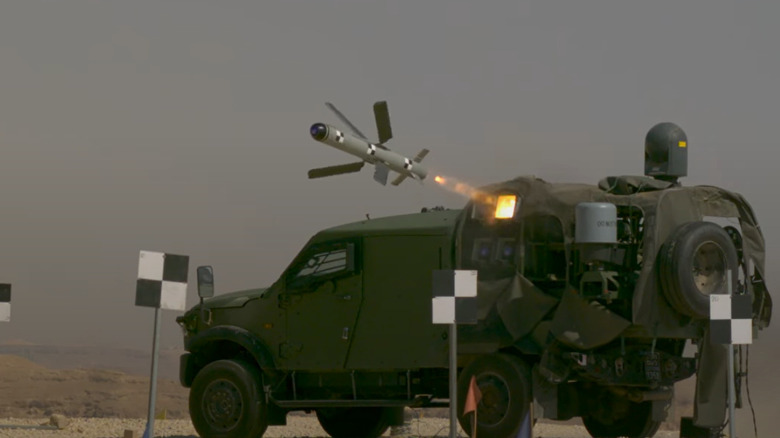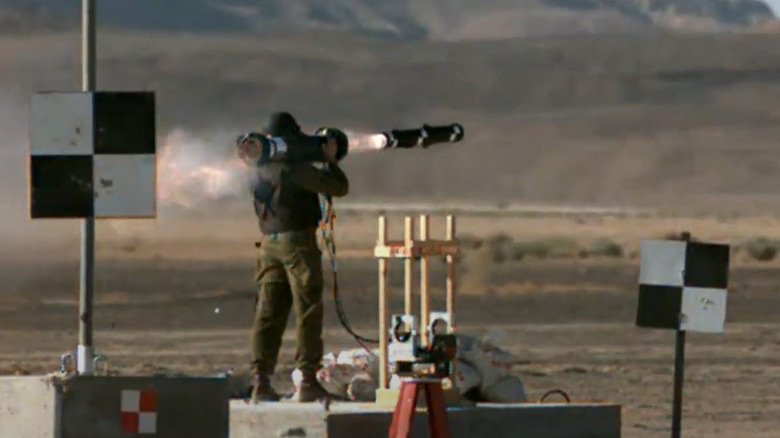Israel's Spike Missile System Might Not Need Boots On The Ground Anymore
As Israel presses forward with its Operation Rising Lion against the Islamic Republic of Iran, its military and intelligence arms are deploying a slew of advanced weapons and tactics that may foreshadow the future of military actions in the Middle East and beyond. With its Iron Dome defense system and the use of advanced missiles like JDAM and Spice bombs, experts may be able to piece together the future of warfare in real time. Perhaps nowhere is this more visible than in the use of unmanned attacks. Once reserved for drone strikes, Israel has escalated its use of remote weapons against Iran over the past half-decade, including assassinating nuclear scientist Mohsen Fakhrizadeh with an AI-assisted remote-operated gun mounted on a pickup truck.
But nowhere has the depth of Israel's remote-operated weapons systems been more on display than the opening barrage of Operation Rising Lion, when Israel deployed two concurrent strings of attacks to disrupt Iran's nuclear silos and missile systems. First, hundreds of drones built and launched from within Iran's borders swarmed Iran's air defenses, clearing the path for 200 fighter jets to attack roughly one hundred Iranian targets, killing nearly 80 people and injuring well over 300. In the days that followed, Iranian state media organizations released details regarding the attacks, including what appeared to be the abandoned remnants of Israel's Spike missile system, which officials state was remotely operated within the country to attack Iran's long-range weaponry. To some, the development marks a significant advancement in remote tactics and could signal a new era of unmanned warfare.
What is Spike?
Spike refers to a family of anti-tank guided missile systems manufactured by the Israeli defense firm Rafael Advanced Defense Systems. The latest versions are equipped with 6th-generation capabilities that use electro-optical and fiber-optic imaging to direct the weapon post-launch. To do so, Spike uses both fiber-optic cables on the launcher and a small camera on the missile itself to help guide it towards the target. Depending on its launch point, Spike missiles' range can extend up to 31 miles.
First debuted by the IDF in the 1980s, Spike missiles have grown into a popular fire-and-forget alternative to Lockheed Martin's Javelin. Deployed by 43 NATO, EU, and allied countries on land, air, and sea missions, Rafael has sold over 30,000 units of its anti-tank weapon. In addition to Israel, this list includes countries like Germany, Canada, and the United Kingdom. One customer, Spain, made headlines in June 2025, when it suspended its $325 million contract to purchase 168 launchers and 1,680 Spike missiles from Rafael. The move came as the Spanish government moved to end its military's technological ties to Israel, as the country's violence in Gaza neared the second-year mark. Rafael, it is important to note, was founded as an IDF research lab, and is one of Israel's three largest military manufacturers, serving as the main supplier of the country's Iron Dome and David's Sling missile defense systems. The United States, for its part, signed an agreement with Rafael's American subsidiary to "Americanize" the anti-tank missile in March 2025.
The war from home revolution
In images released by Iranian state media just five days after Operation Rising Lion's initial sojourn, Iranian intelligence displayed remnants of Spike missile systems, which it claimed Mossad agents used to target Iran's air defenses during the offensive. According to Tehran, these missiles were controlled remotely by internet-based automation systems. In an exposé by The War Zone, the images were identified as showcasing missile launchers, hardware components, and small ground-mounted turrets. In addition to the Spike missile equipment, Iran stated it had discovered drone factories in Isfahan and Shahr-e Ray.
Israel's tactics reflect a broader strategy as militaries seek to orchestrate covert actions on foreign soil. Take, for instance, Ukraine's Operation Spider's Web, in which members of its security service smuggled 117 "kamikaze" drones deep into Russian territory. The drones then attacked several key Russian bases on June 1, damaging up to 41 aircraft on bases as far as 3,000 miles away from the Ukrainian capital of Kyiv. Similarly, Russia has deployed thousands of autonomous kamikaze drones in attacks on Ukrainian cities.
Together, these examples demonstrate militaries' pursuit of new remote attack methods. Unquestionably connected to this trend is the increasing development of lethal autonomous weapons systems, a development that raises broader legal, moral, and human rights concerns about the dangers posed by remotely operated weapons increasingly augmented by AI-powered targeting methods. As critics, like the U.N. Secretary General António Guterres, push for stricter control of semi-autonomous targeting systems, these conflicts are sure to give advocates and detractors plenty of material to fuel their respective arguments.


